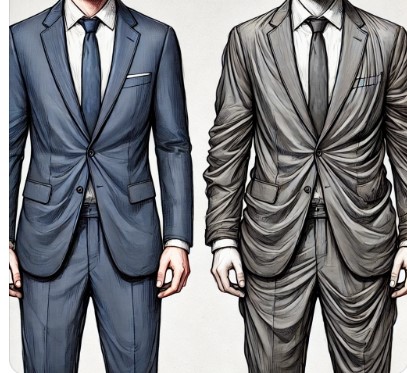So, you’re dressing on a budget but still want to look sharp in a suit. One of the best pieces of advice is to grab an off-the-rack suit that fits as well as possible and take it to a tailor for adjustments. Sounds simple, right? That advice is solid, and you’ll see it repeated across tons of style guides.
But here’s the thing: to really get the most out of your tailor and your suit, you need to know what can be adjusted—and what can’t. Even more important, you need to know what a “good fit” actually looks like in the first place. After all, not all tailors are the same, and not all adjustments are easy to communicate.
To make things easier, let’s walk through the essentials of how your suit should fit. Once you nail these areas, you’ll have a sharp, tailored look without breaking the bank. Let’s get started!
What Does a “Good Fit” Look Like?
First things first—when you’re trying on a suit, do it in your “natural stance.” What does that mean? It’s standing up straight, feet planted, arms relaxed by your side. Ideally, you should wear the same dress shoes you’ll use with the suit. It might feel a little formal, but it’s the best way to gauge if the suit moves with your body. If it doesn’t fit well while standing still, it won’t feel comfortable when you’re on the move.
Here’s what to check for:
The Shoulders
The shoulders are key. They set the foundation for the rest of your suit. A good shoulder fit means the seam at the top lies flat and lines up with your shoulder bone. The seam should meet the sleeve right where your arm meets your shoulder.
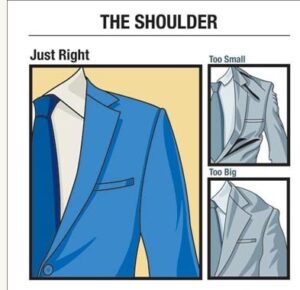
What to avoid:
- If the shoulder seam is too high, the sleeve will scrunch up and create wrinkles.
- If it hangs down too far, it’ll droop and make the suit look baggy.
In both cases, you’ll get lumps and ripples on the jacket. Here’s the kicker—shoulders are one of the hardest areas to adjust. If the shoulders don’t fit, don’t assume a tailor can fix it. Move on to a different jacket.
The Seat of Your Trousers
The back of your trousers (aka the “seat”) should drape smoothly over your butt. Whether you’ve got a more athletic build or a slimmer frame, the fit should lie comfortably against your body without pulling too tightly or sagging down your thighs.
What to avoid:
- If you see tight horizontal wrinkles under your butt, the trousers are too snug.
- If you notice loose, sagging folds in the back, they’re too big.
Here’s some good news: a tailor can often fix a saggy seat by taking it in. But if the pants are too tight, don’t expect miracles. There’s only so much fabric a tailor can let out.
Trouser Break
What’s the “break” of your trousers? It’s that little wrinkle formed where the cuff of your pants hits the top of your shoe. Ideally, you want a single, subtle crease at the front. This indicates the trousers are long enough to reach your shoes without bunching up.
What to avoid:
- If there’s too much fabric bunched around the ankles, the trousers are too long.
- If there’s no break at all and your socks are visible while standing, they’re too short.

The great news? Trouser length is one of the easiest things to adjust, and most dress pants are sold unhemmed so you can get them tailored to the perfect length.
Jacket Closure
Now, let’s talk about the jacket closure. When you button your jacket (remember, just the top button if it’s a two-button suit), you should feel snug without any pulling or straining.
What to avoid:
- If you see a noticeable “X” shape forming across the front when buttoned, the jacket is too tight.
- If the jacket flares out at the bottom like a bell, it’s too loose.
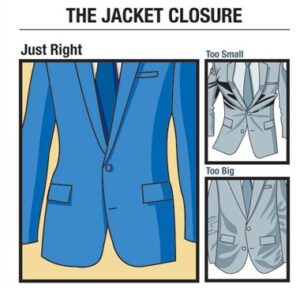
A good tailor can take in or let out the waist a little, but don’t count on them to perform miracles. If it looks off when buttoned, it’s probably not the right fit to begin with.
Sleeve Length
Here’s a classic rule: when your arms are relaxed at your sides, about half an inch of your shirt cuff should show beyond the jacket sleeve. It gives the suit a clean, finished look. The sleeve itself should end just above your wrist bone.
What to avoid:
- If the sleeve completely covers your shirt cuff or goes past your wrist, it’s too long.
- If too much of the shirt cuff shows, the sleeve is too short.
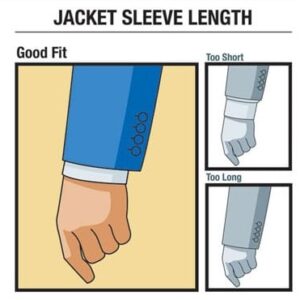
This is another easy fix for a tailor. If you’re between lengths, it’s better to have a sleeve that’s too long and adjust it.
Jacket Length
Not enough people talk about jacket length, but it’s one of the most important parts of suit fit. A properly fitted jacket should cover about 80% of your butt and crotch. The hem of the jacket should land somewhere around the middle of your thumb when your arms are hanging naturally.
What to avoid:
- A jacket that ends too high will make your torso look shorter and mess with your proportions.
- If the jacket is too long and drapes past your hands, it’ll look oversized and dated.
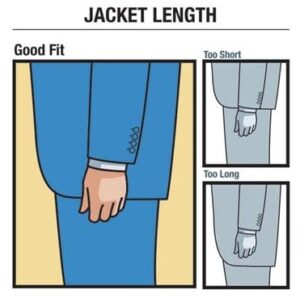
While you can have the hem of a jacket adjusted, you’re limited in how much can be done without affecting the pockets. If it’s way too long or too short, you’re better off trying a different size or cut.
Jacket Collar
The collar is one of those little details that makes a big difference. A good fit means your jacket collar rests neatly against your shirt collar, which should, in turn, rest against your neck.
What to avoid:
- A collar that’s too loose will flop around and leave a gap behind your neck.
- A collar that’s too tight will cause bunching and wrinkling at the back.

Collar adjustments can be tricky and expensive, so it’s best to start with a jacket that already fits well in this area.
Automatic “Bad Fit” Warnings
While there’s room for tailoring in most areas, there are a few telltale signs that a suit just won’t ever fit right. If you notice any of these issues, it’s best to move on to another suit.
- The Dreaded “X” Button Strain: If the fabric pulls and creases into an “X” when you button the jacket, it’s too small. It’s not just the waist—this usually means issues in the shoulders or back, too.
- Shoulder Divots or Wrinkles: If the shoulder padding is sticking out past your arm and the fabric dips back in, the jacket is too big. Likewise, if there are wrinkles on top of the shoulders, the jacket is too large and your body isn’t filling it out.
- Twisted Sleeves: If the sleeves look twisted or spiraled, it’s usually because the angle of your arms doesn’t match the way the jacket was constructed. This is an expensive fix, so it’s better to pass on that jacket altogether.
The Bottom Line
Finding the perfect suit is all about understanding what can be tailored and what can’t. An off-the-rack suit can be a great option, but you have to start with a fit that’s close to perfect. A tailor can only do so much, so if you notice major issues like shoulder divots, a poor collar fit, or excessive button strain, keep searching.
Remember, the right fit will make you look sharp and feel confident, whether it’s for a wedding, job interview, or just leveling up your wardrobe. Now that you know what to look for, you’ll be able to spot a good fit from a mile away!
